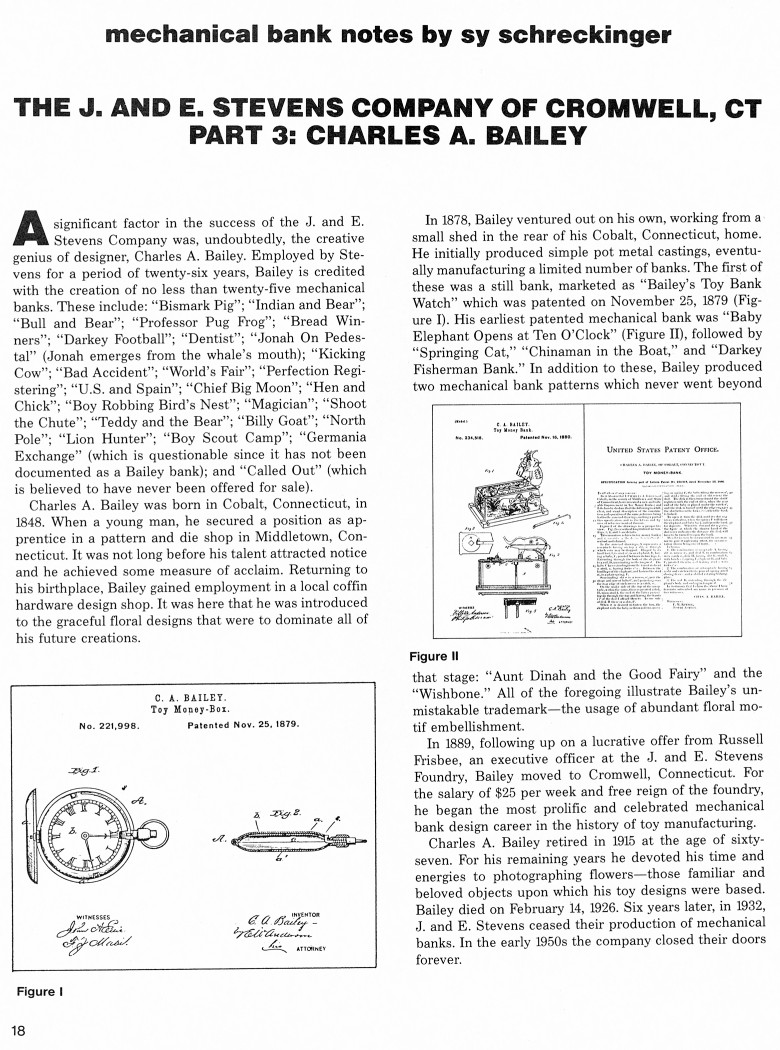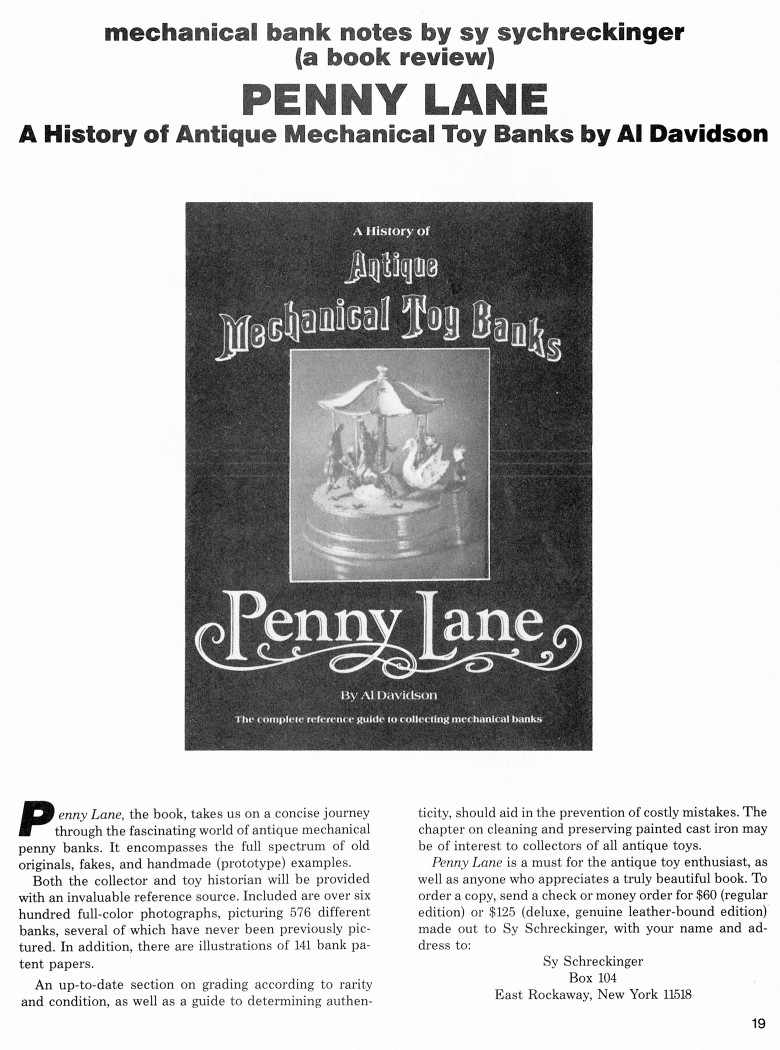|
The J. & E. Stevens Co. of Cromwell, Conn.
Part 3: Charles A. Bailey
by Sy Schreckinger – ANTIQUE TOY WORLD Magazine – May/June, 1988
A significant factor in the success of the J. and E. Stevens Company was,
undoubtedly, the creative genius of designer, Charles A. Bailey. Employed
by Stevens for a period of twenty-six years, Bailey is credited with the
creation of no less than twenty-five mechanical banks. These include: "Bismark
Pig"; "Indian and Bear"; "Bull and Bear"; "Professor Pug Frog"; "Bread
Winners"; "Darkey Football"; "Dentist"; "Jonah On Pedestal" (Jonah emerges
from the whale's mouth); "Kicking Cow"; "Bad Accident"; "World's Fair";
"Perfection Registering"; "U.S. and Spain"; "Chief Big Moon"; "Hen and
Chick"; "Boy Robbing Bird's Nest"; "Magician"; "Shoot the Chute"; "Teddy
and the Bear"; "Billy Goat"; "North Pole"; "Lion Hunter"; "Boy Scout
Camp"; "Germania Exchange" (which is questionable since it has not been
documented as a Bailey bank); and "Called Out" (which is believed to have
never been offered for sale).
Charles A. Bailey was born in Cobalt, Connecticut, in 1848. When a
young man, he secured a position as apprentice in a pattern and die shop
in Middletown, Connecticut. It was not long before his talent attracted
notice and he achieved some measure of acclaim. Returning, to his
birthplace, Bailey gained employment in a local coffin hardware design
shop. It was here that he was introduced to the graceful floral designs
that were to dominate all of his future creations.
In 1878, Bailey ventured out on his own, working from a small shed in
the rear of his Cobalt, Connecticut, home. He initially produced simple
pot metal castings, eventually manufacturing a limited number of banks.
The first of these was a still bank, marketed as "Bailey's Toy Bank Watch"
which was patented on November 25, 1879 (Figure I). His earliest patented
mechanical bank was "Baby Elephant Opens at Ten O'clock" (Figure II),
followed by "Springing Cat ... "Chinaman in the Boat," and "Darkey
Fisherman Bank." In addition to these, Bailey produced two mechanical bank
patterns which never went beyond that stage: "Aunt Dinah and the Good
Fairy" and the "Wishbone." All of the foregoing illustrate Bailey's
unmistakable trademark — the usage of abundant floral motif embellishment.
In 1889, following up on a lucrative offer from Russell Frisbee, an
executive officer at the J. and E. Stevens Foundry, Bailey moved to
Cromwell, Connecticut. For the salary of $25 per week and free reign of
the foundry, he began the most prolific and celebrated mechanical bank
design career in the history of toy manufacturing.
Charles A. Bailey retired in 1915 at the age of sixty-seven. For his
remaining years he devoted his time and energies to photographing
flowers — those familiar and beloved objects upon which his toy designs were
based. Bailey died on February 14, 1926. Six years later, in 1932, J. and
E. Stevens ceased their production of mechanical banks. In the early 1950s
the company closed their doors forever.
Penny Lane (a book
review)
A History of Antique
Mechanical Toy Banks by Al Davidson
by Sy Schreckinger – ANTIQUE TOY WORLD Magazine – May/June, 1988
Penny Lane, the
book, takes us on a concise journey through the fascinating world of
antique mechanical penny banks. It encompasses the full spectrum of old
originals, fakes, and handmade (prototype) examples.
Both the collector and toy historian will be provided with an
invaluable reference source. Included are over six hundred full-color
photographs, picturing 576 different banks, several of which have never
been previously pictured. In addition, there are illustrations of 141 bank
patent papers.
An up-to-date section on grading according to rarity and condition,
as well as a guide to determining authenticity, should aid in the
prevention of costly mistakes. The chapter on cleaning and preserving
painted cast iron may be of interest to collectors of all antique toys.
Penny Lane is a must for the antique toy enthusiast, as well as
anyone who appreciates a truly beautiful book. To order a copy, send a
check or money order for $60 (regular edition) or $125 (deluxe, genuine
leather-bound edition) made out to Sy Schreckinger, with your name and
address to: Sy Schreckinger, Box 104, East Rockaway, New York 11518
|


